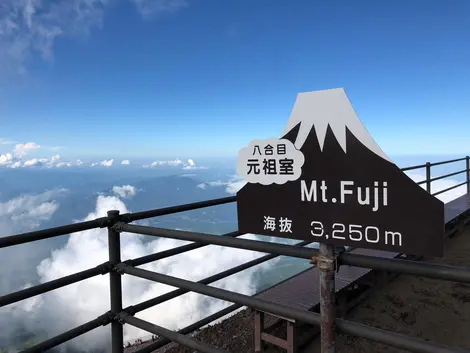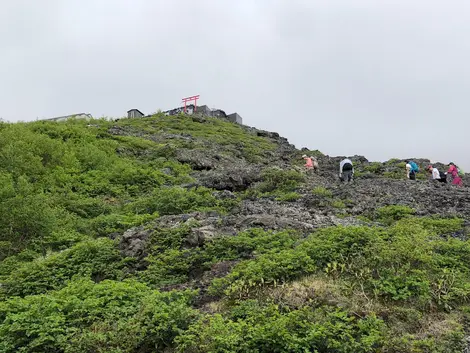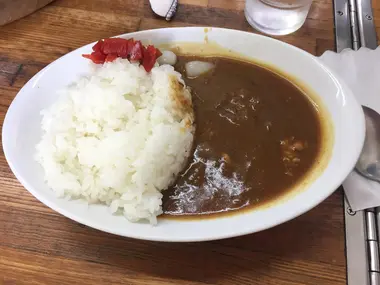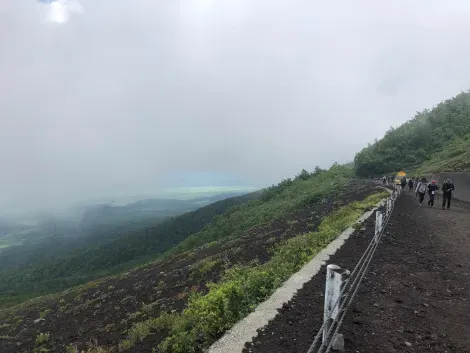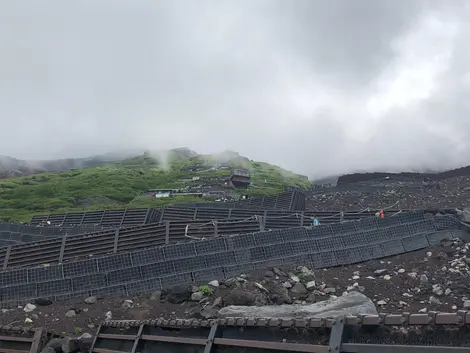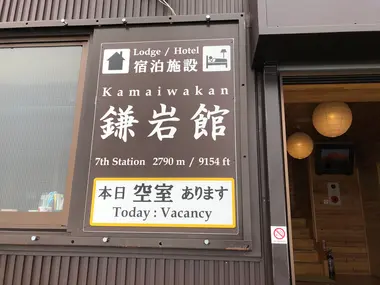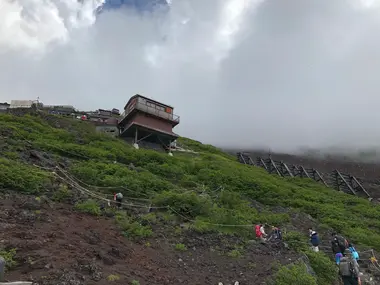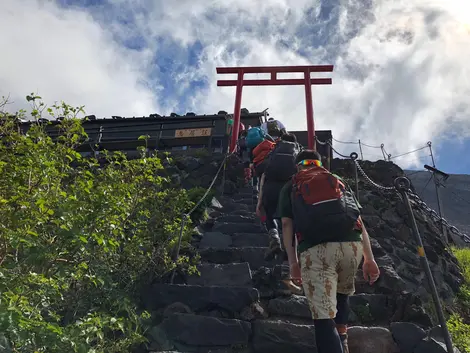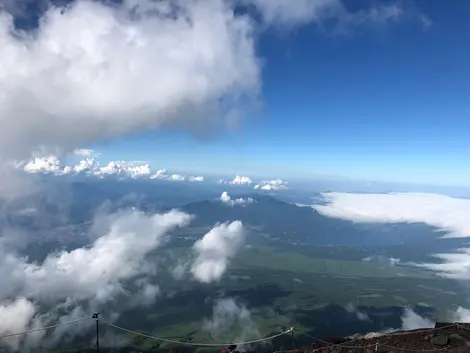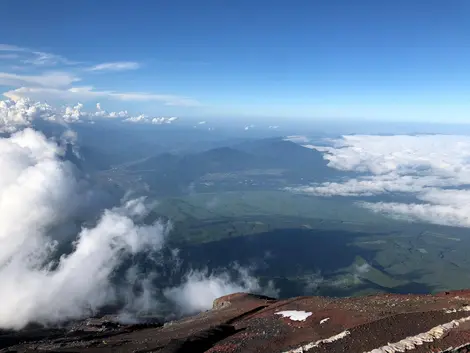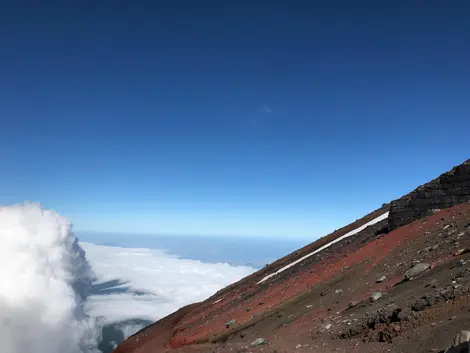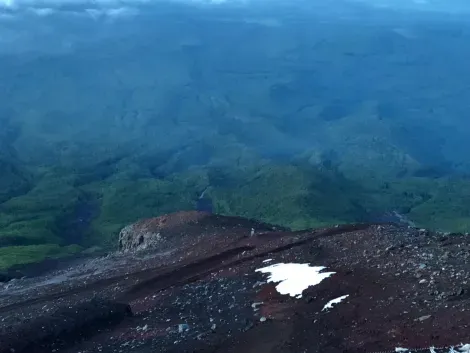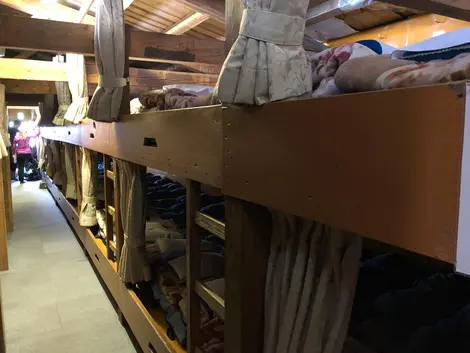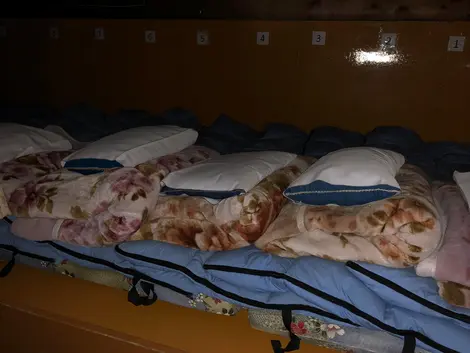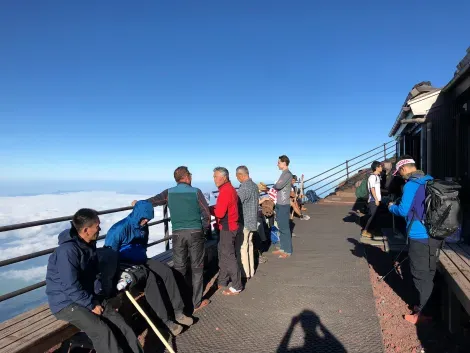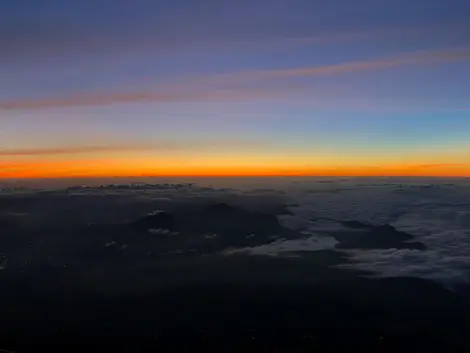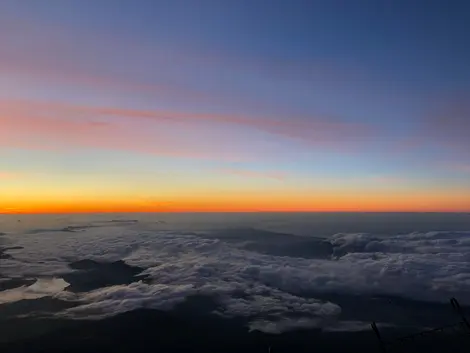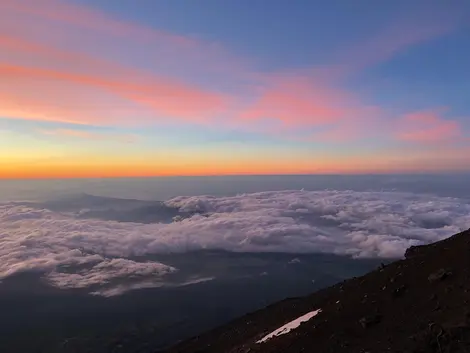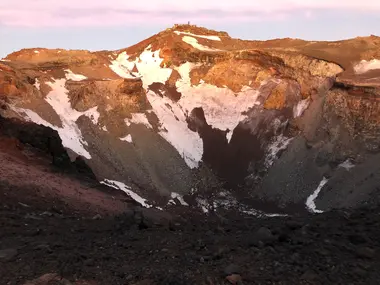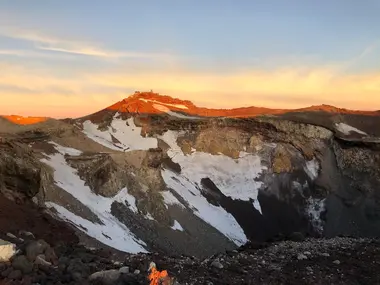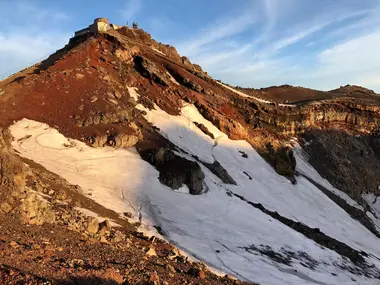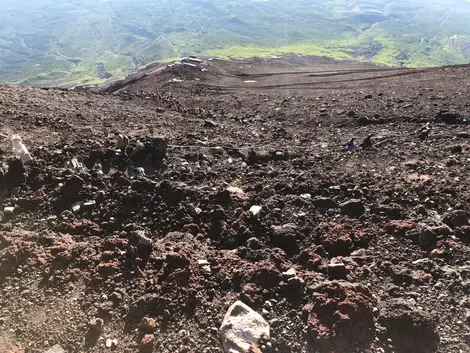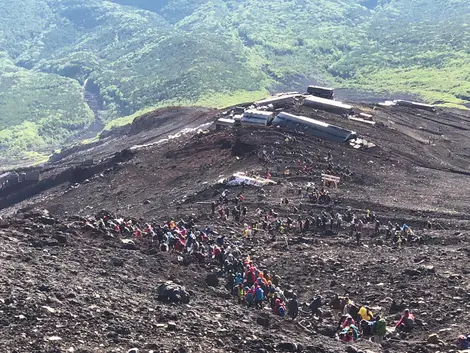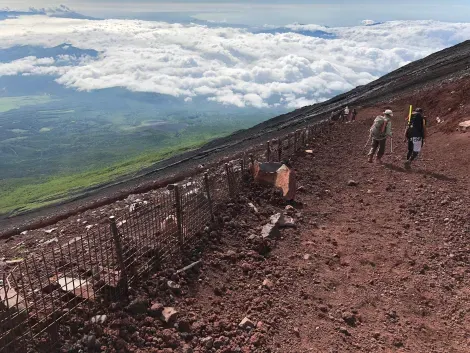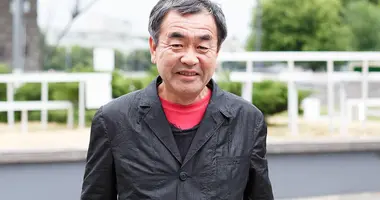Feature: Climbing Mount Fuji
- Published on : 06/07/2018
- by : A.B.
- Youtube
A challenge to the sacred volcano
Japan Experience climbed Mount Fuji as soon as the slopes of the volcano opened in early July. After five hours of effort, a reward: the sunrise from the summit, a magical moment.
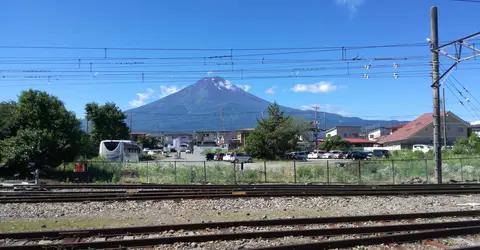
Mount Fuji seen from Kawaguchiko Station
ABA
Monday, July 2, 2018, 8:37 a.m. We arrive at Kawaguchiko station, a town nestled between the lake of the same name and Mount Fuji. Behind the railroad tracks we have the first vision of the volcano , whose perfect lines soar towards an azure sky.
We queue for a few minutes at the station counter, among other Western and Asian travellers, to buy our bus ticket, destination the fifth station, the starting point of the ascent .
On the way to the 5th station
9:30 a.m. The Fujikyu bus arrives at the bus station platform at the scheduled time. We exchange a few words with travelers from Colorado. “It's our first ascent, confides the father of the family. I don't think we'll go all the way to the top, but we'll try to go as high as possible,” he promises.
The bus is full. We sit on the folding seats, our bags placed at the feet. The bus does not take long to start. Leaving the city, the machine spins through a ribbon of bitumen which splits the forest in two at the foot of the volcano . The long straight line soon curls up in switchbacks to climb the first slopes. Cradled by the road and drowned in a green landscape, we doze for a few moments. The driver's announcement on the microphone wakes us up. It is 10:25 a.m. , we arrived at the “ Fuji Subaru 5 th station ” bus station. The rest of the ascent will be on our own.
The ascent begins
When we got off the bus, the temperature cooled slightly: the mercury was 18 degrees . The sky clouded over a bit. From the top of our 2,305 meters above sea level , we literally had our heads in the clouds. It remains a little less than 1,500 meters to the summit . That's nearly four times the Empire State Building.
We then have a thought for the pioneers of Mount Fuji who, more than a millennium ago, accomplished the ascent from the foot of the volcano . If this performance is still achievable, nowadays the bulk of hikers choose the fast track, the one that starts from the 5th station and allows you to spend the night near the summit before admiring the sunrise the next day. This is the choice we made. We have a few hours before starting the ascent: a useful time to acclimatize to the altitude . And to swallow a curry rice in one of the station's fast food restaurants.
See: Japanese curry
1:30 p.m. Let's go. We take the Yoshida route , on the northern flank, the most strenuous of the four possible routes, and also the only one open from July 1st . The other three are still too dangerous because of the remnants of snow. The dirt road is flat for a few minutes. A gentle start that invites conversation and contemplation. We observe the vegetation, still dense, by turning our gaze from time to time towards the heights of the volcano. Surprisingly, the dirt road soon descends for two or three minutes, before a first fork. The small wooden sign indicates the right path, the one that goes up to the summit . It will be 2 p.m., we are getting to the heart of the matter.
To read: Top 5 hikes to do in Japan
The slope steepens
We are now treading on stones that were once the lava that escaped from the crater . The geological time scale, which is counted in millions of years, reminds us of our humble condition. We cross a concrete shelter , which, for a few tens of meters, serves as a refuge in the event of a storm. Useless today: the weather will remain mild throughout the ascent . A chance in the middle of the rainy season in Japan.
We are approaching the sixth station , located at an altitude of 2,390 meters. A first stage before a much longer stretch to the seventh station, perched 300 meters higher. The hardest is yet to come.
The head is spinning a bit for one of us. Probably the lack of oxygen . We then pause for a few minutes. As we leave, we meet the father from Colorado, with his wife and son, who left a little earlier. As expected, they did not tempt the devil. "Enjoy !" they encourage us on the way down.
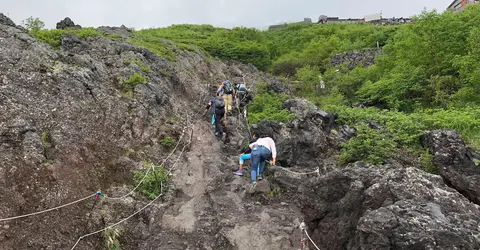
Hiking turns into climbing?
TMA
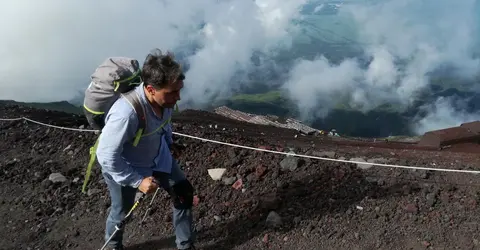
Our special correspondent!
ABA
The rest of the climb is far from easy. While the vegetation is now sparse, the slopes of the volcano are steep . At first docile, Mount Fuji gradually displayed its arguments. The sacred mountain cannot be dominated like that. At times we have to use our hands to grab certain rocks in order to step over them and progress. We then realize the need for good hiking shoes : their grip allows you to go from one rock to another without fear of slipping.
As you climb, the trail narrows . The slower pace of those in front of us sometimes forces us to wait, sometimes to find an opening on the side to overtake, even if it means taking a less easy path . Another chance that the Japanese school year is not yet over: we should have also mixed with the cohorts of high school students who survey the volcano during the summer holidays.
The first shelters
3 p.m. Looking up, we see small buildings lined up here and there on the side of the mountain. Sign that we are approaching the seventh station , which marks the location of the first refuges . We are close to 2,700 meters above sea level .
Higher up, white spots dot the ocher sides of the volcano. It is that, while the heat wave rages throughout Japan, here the last snows of June have not yet melted.
We pause again, snack on an onigiri and a cereal bar, sitting facing the void . We regain our strength, taking care to breathe deeply to overcome the scarcity of oxygen .
Young hikers pass us. “Where are you from?” we ask them. “Kazakhstan”, they reply, before continuing on their way.
Mount Fuji attracts travelers from all over the world in search of a challenge.
No time to linger: the objective is to arrive at the eighth station before nightfall . We are moving on again.
Arrival at the 8th station
It is 4:30 p.m. when we arrive at the “ Fujisan Hotel ”, where we have booked one night. The accommodation is only a hotel in name: it is a long dormitory set up above a dining room with a few tables. Our host welcomes us, explains the terms and imposes the dinner time: 5:15 p.m. It will be a curry rice, our second of the day. At 3,380 meters above sea level , we are not going to be choosy. We put our things in the dormitory and go out to breathe and admire the view. Between two clouds, we rediscover, seen from the sky, the city of Kawaguchiko , which we had left in the morning, and its lake. A little further to the right, towards the east, another body of water: Lake Yamanakako . In the middle, the plains and the forest deploy greenery in all its shades.
Also read: Fujigoko, the 5 lakes region
Curry time has come. We sit down and gulp down the dish in a few minutes, not without treating ourselves to a healthy beer . The rest of the evening is free. We set our alarm clock at 2:15 a.m .: the time at which we will have to resume our ascent, at night, to reach the summit before sunrise, expected around 4:30 a.m.
And the light came
We sleep lightly. Lack of space, excitement, noise from surrounding travelers: the ambient bustle wakes us up a few minutes before the hour. We follow the movement. It's time to get back to the top .
One of us is not feeling well. "My head hurts too much. Go without me”. Victim of the famous kôzanbyô , the acute mountain sickness linked to the lack of oxygen , he will remain bedridden until morning. The ascent stops there for him.
We strap on our headlamps and join the stream of hikers who have all left their refuges to answer the call of the summit.
The race against the sun has begun.
Above our heads, the night offers a sky free from all light pollution . Alongside the Big Dipper, the North Star, suspended above Kawaguchiko, points us to the north. The wind is intense, the biting cold. We put on gloves, hats and a few extra layers of clothing. That's what we were told: the temperature sometimes drops below zero at the top , even in the middle of summer.
It is 4 a.m. when we reach the heights of the goraikô , literally: where “the light comes” , the place designated to admire the dawn. We arrived well before the sun. To wait, we eat the bentô served at the refuge: white rice accompanied by a piece of meat that looks like dog food. Again, we'll go with it.
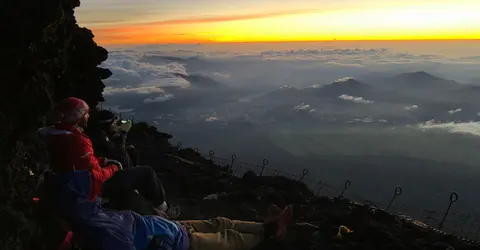
In place to watch the show
TMA
The first lights pierce the night and soon turn the sky purple, revealing a morning landscape of the world . We then understand the fascination of the Japanese for Mount Fuji which, before being a volcano, is first and foremost a sacred mountain, the domain of the kami , the deities of Nature . The solar star finally emerges from the horizon, like a promise kept, illuminating the faces of all the hikers who have come to share this moment of eternity. We then realize one thing: we are on the roof of Japan, the Land of the Rising Sun.
The tour of the crater
The light came, we then undertake to achieve what the Japanese call the ohachi meguri , translation: the tour of the crater . Overlooking on one side the 3,776 meters of void, on the other the still snow-covered tank of the summit , we admire the panorama which is offered to us. Going around Mount Fuji's crater is a bit like going around Japan : we overlook not only the surrounding towns and forests , but also Suruga Bay and the Izu Peninsula to the south. To the east, the buildings of Yokohama , tiny from here, tear up the horizon and suggest, further on, Tokyo and its megalopolis. Japan suddenly seems small to us.
Lowering
It is past 6 a.m. when we begin to descend. After a stop at the refuge to sip a coffee, we make the journey in the opposite direction . After a few minutes, we arrive at the junction where a young Japanese official, posted there, an armband around her arm, tells us in English the direction of the path dedicated to the descent. We then take a sloping path, less abrupt than on the outward journey , but testing by the weight exerted on the knees and the accumulated fatigue.
After two hours of walking, the vegetation becomes abundant again, and with it the butterflies. We pass the sixth station and then find the flat path that we had taken the day before. We eventually arrive at the fifth station, the end point of our adventure. Tired but happy with the challenge accomplished, we take the bus that will take us back to civilization.
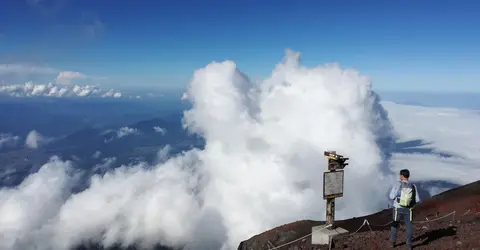
Our special envoy in full contemplation
ABA
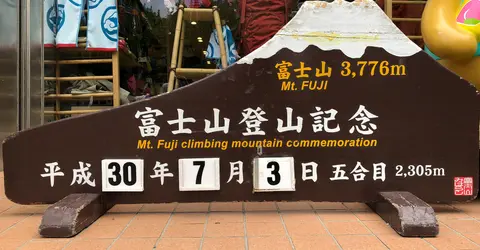
Started on July 2 at 1:30 p.m., the adventure ends the next morning
TMA



